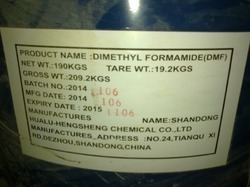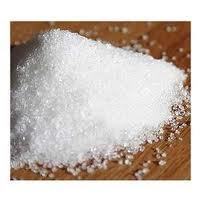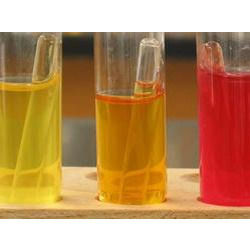Acetonitrile
Acetonitrile Specification
- EINECS No
- 200-835-2
- Heavy Metal (%)
- 0.00005%
- Boiling point
- 81.6C
- Assay
- 99.9% Min
- Molecular Weight
- 41.05 g/mol
- Molecular Formula
- C2H3N
- Ph Level
- 6.07.0 (20C, 200 g/l in H2O)
- Place of Origin
- India
- Viscosity
- 0.369 mPas at 25C
- Residue on Ignition
- 0.0003%
- Melting Point
- -45C
- HS Code
- 29269000
- Storage
- Keep tightly closed, Store in a cool and dry place
- Moisture (%)
- < 0.03%
- Acid Value
- < 0.0001 meq/g
- Other Names
- Methyl cyanide, MeCN, Cyanomethane
- CAS No
- 75-05-8
- Type
- Industrial Chemical
- Grade
- HPLC, Analytical, Industrial
- Usage
- Pharmaceutical Intermediates, HPLC Solvent, Laboratory Use, Synthesis
- Purity
- 99.9%
- Appearance
- Clear, Liquid
- Application
- Pharmaceuticals, Organic Synthesis, Laboratory, Analytical Reagent
- Raw Material
- Acetylene and Ammonia
- Smell
- Ether-like
- Color
- Colorless
- Form
- Liquid
Acetonitrile Trade Information
- Minimum Order Quantity
- 25 ,
- Payment Terms
- Letter of Credit (L/C), Western Union, Paypal, Cash in Advance (CID), Cash Advance (CA)
- Supply Ability
- 500 Per Week
- Delivery Time
- 7 Days
- Sample Available
- Yes
- Sample Policy
- Sample costs shipping and taxes has to be paid by the buyer
- Main Export Market(s)
- Western Europe, Middle East, Central America, Eastern Europe, South America, Australia, Asia, North America, Africa
- Main Domestic Market
- All India
About Acetonitrile
Acetonitrile
160 Kgsx80 Drumsx1 Fcl
Specification
| Test items | Specifications | Results |
| Appearance | Colorless, | Colorless, |
| Specific gravity, 20/20°c | 0.782~0.785 | 0.783 |
| Distillation range, °c | 80.0~82.0 | 80.9~82.0 |
| Acetonitrile, %wt | 99.9 min. | 99.74 |
| Water. %wt | 0.05 max. | 0.0180 |
| Copper, ppm | 0.3 max. | < 0.1 |
| Iron, ppm | 0.3 max. | < 0.1 |
| Color. Apha/pt-co | 10 max. | 5 |
| Acidity(as ch3cooh), %wt | 0.005 max. | 0.0009 |
| Propion1trile, ppm | 500 max. | 331 |
| Acrylonitrile, ppm | 5 max. | N.d. |
| Acetone, ppm | 5 max. | N.d. |
| Hcn. ppm | 10 max. | 1.0 |
| Free ammonia, ppm | 6 max. | 2. |
| Allyl alcohol, ppm | 30 max. | N.d. |
High Purity and Reliable Performance
Our Acetonitrile guarantees an assay of at least 99.9%, meeting rigorous HPLC and analytical grade standards. This consistent purity ensures precise results in laboratory work, pharmaceutical synthesis, and industrial processes. Supplied in secure packaging options, from drums to bulk tankers, our product supports demanding applications with reliable quality.
Versatile Applications Across Industries
Valued for its miscibility with water, alcohol, and ether, Acetonitrile serves as an essential reagent for organic synthesis, a top choice for HPLC solvents, and a reliable laboratory chemical. Its stable, clear liquid form and low impurities make it integral in pharmaceutical manufacturing, analytical chemistry, and multiple industrial sectors.
Safe Storage and Handling Precautions
Due to its toxic properties and low flash point (2C), Acetonitrile requires careful handling and storage. Keep containers tightly closed and store the chemical in a cool, dry place away from ignition sources. With a shelf life of 24 months unopened, following recommended guidelines ensures product safety and longevity.
FAQs of Acetonitrile:
Q: How should Acetonitrile be stored to maintain its quality and safety?
A: Acetonitrile must be stored tightly closed in a cool, dry place, away from direct sunlight and heat sources. Proper storage preserves its 99.9% purity and prevents degradation or moisture contamination. For optimal safety and shelf life, ensure containers remain sealed until use.Q: What are the main industrial and laboratory uses of Acetonitrile?
A: Acetonitrile is widely used in pharmaceuticals as an intermediate, as a solvent for High Performance Liquid Chromatography (HPLC), in organic synthesis, and as an analytical reagent. Its excellent miscibility and low impurity profile make it ideal for precision applications across varied sectors.Q: When is Acetonitrile considered expired or unusable for sensitive applications?
A: Acetonitrile retains suitability for sensitive applications up to 24 months from its manufacturing date if the container remains unopened. After this period, or if contamination occurs, the chemical may no longer meet required purity standards and should not be used for critical tasks.Q: Where does Acetonitrile originate, and what is its standard packaging?
A: Our Acetonitrile is manufactured and exported from India, supplied in 160 kg drums, 20 litre jerry cans, or bulk tankers. The choice of packaging ensures safe transport and storage for both small-scale laboratories and large industrial buyers.Q: What is the production process and capacity for Acetonitrile?
A: Acetonitrile is produced using a synthesis of acetylene and ammonia. Our facilities offer a production capacity of 500 metric tons per month, ensuring consistent availability and scalability for diverse requirements, from minimum orders of 200 litres to bulk supplies.Q: Is Acetonitrile safe to use, and what precautions should be taken during handling?
A: Acetonitrile is toxic if inhaled or ingested, and has a low flash point (2C). It should be handled using appropriate personal protective equipment, in well-ventilated areas, and kept away from sources of ignition to reduce health and safety risks.Q: What advantages does Acetonitrile offer as an HPLC solvent?
A: Its high assay (99.9%), low residue, and miscibility make Acetonitrile exceptionally suitable for HPLC applications, delivering reliable separation and reproducibility, essential for analytical accuracy in chemical laboratories and pharmaceutical research.

Price:
- 50
- 100
- 200
- 250
- 500
- 1000+
More Products in Pharma Chemicals Category
Dimethylformamide Chemical
Price 67 INR
Minimum Order Quantity : 25 Kilograms
Grade : Other, Industrial Grade
Form : Liquid
Purity : 99.8%
Place of Origin : India
Dimethyl Formamide DMF
Price 57 INR
Minimum Order Quantity : 25 Kilograms
Grade : Other, Industrial, Pharma
Form : Liquid
Purity : 99.9%
Place of Origin : India
Butylated Hydroxy Toluene
Price 300 INR
Minimum Order Quantity : 25 Kilograms
Grade : Other, Food grade, USP, Technical grade
Form : Solid
Purity : >99%
Place of Origin : India
Alpha Naphthol
Price 190 INR
Minimum Order Quantity : 25 Kilograms
Grade : Other, Reagent/Technical
Form : Solid
Purity : 99% Min
Place of Origin : India
 English
English Spanish
Spanish French
French German
German Italian
Italian Chinese (Simplified)
Chinese (Simplified) Japanese
Japanese Korean
Korean Arabic
Arabic Portuguese
Portuguese Send Inquiry
Send Inquiry




 Send Inquiry
Send Inquiry Send SMS
Send SMS Call Me Free
Call Me Free
